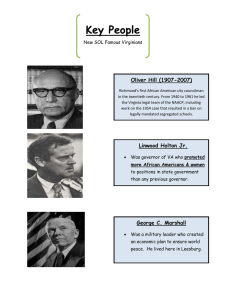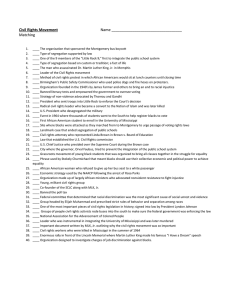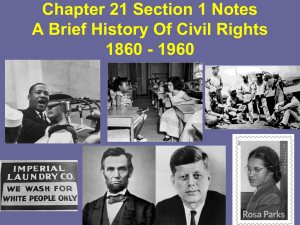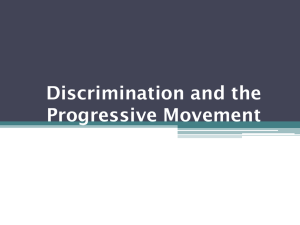How did Progressive movements of the late 1800's reform civil society?
advertisement
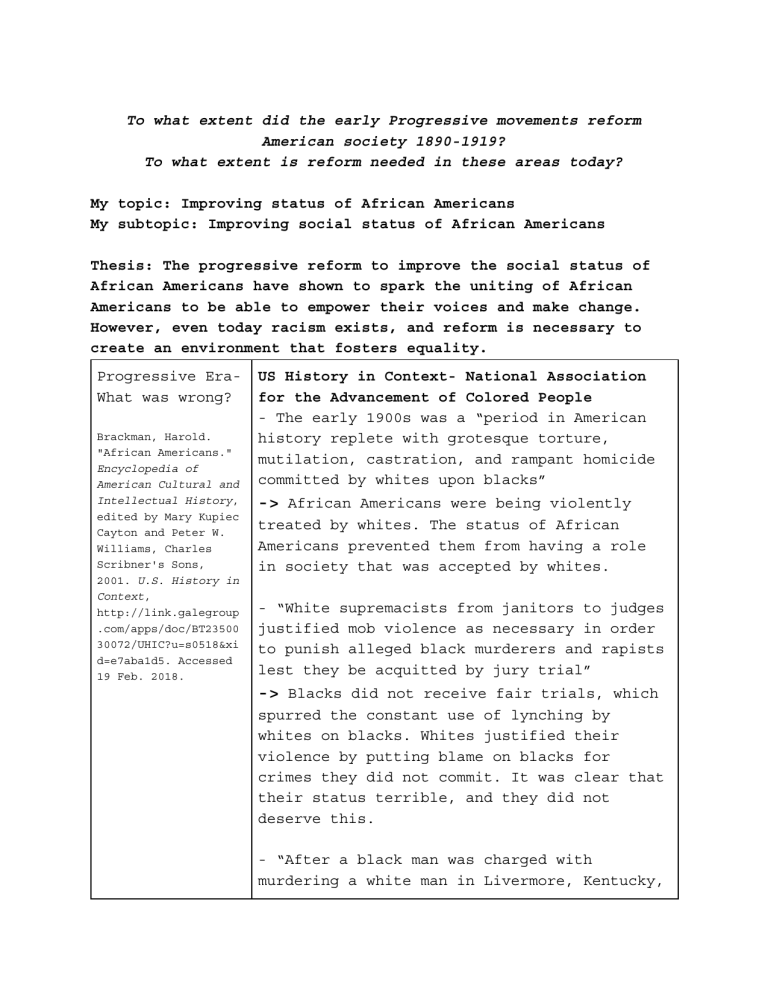
To what extent did the early Progressive movements reform American society 1890-1919? To what extent is reform needed in these areas today? My topic: Improving status of African Americans My subtopic: Improving social status of African Americans Thesis: The progressive reform to improve the social status of African Americans have shown to spark the uniting of African Americans to be able to empower their voices and make change. However, even today racism exists, and reform is necessary to create an environment that fosters equality. Progressive EraWhat was wrong? Brackman, Harold. "African Americans." Encyclopedia of American Cultural and Intellectual History, edited by Mary Kupiec Cayton and Peter W. Williams, Charles Scribner's Sons, 2001. U.S. History in Context, http://link.galegroup .com/apps/doc/BT23500 30072/UHIC?u=s0518&xi d=e7aba1d5. Accessed 19 Feb. 2018. US History in Context- National Association for the Advancement of Colored People - The early 1900s was a “period in American history replete with grotesque torture, mutilation, castration, and rampant homicide committed by whites upon blacks” -> African Americans were being violently treated by whites. The status of African Americans prevented them from having a role in society that was accepted by whites. - “White supremacists from janitors to judges justified mob violence as necessary in order to punish alleged black murderers and rapists lest they be acquitted by jury trial” -> Blacks did not receive fair trials, which spurred the constant use of lynching by whites on blacks. Whites justified their violence by putting blame on blacks for crimes they did not commit. It was clear that their status terrible, and they did not deserve this. - “After a black man was charged with murdering a white man in Livermore, Kentucky, tickets were sold at a local theater to witness and participate in his lynching. The audience in the orchestra could fire unlimited shots into Will Porter's lifeless body, while those in the gallery were limited to only one” -> Mob mentality grew immensely during this period of time. Many people justified their participation in these mobs solely from the fact that others were being violent too. Groups of whites joined together and committed horrible acts of violence. A clear divide between races still existed in the nation; whites still looked down on blacks. US History in Context- African Americans - “Jim Crow segregation was imposed and the freedmen were reduced to the status of second-class citizens” - “African Americans were terrorized into accepting the rigid system of Jim Crow racial subordination, as lynchings of blacks increased from 12 in 1872 to 255 in 1892” - “Southern culture became increasingly violent in the late nineteenth century, with blacks often victimized by other blacks as well as whites” -> Jim Crow laws caused blacks to be seen as inferior to whites. After winning their basic citizen rights, those rights were essentially stripped from them as they lost their ability to participate politically and have a fair social status. Attempts/goals to improve condition US History in Context- National Association for the Advancement of Colored People - NAACP “was founded in 1909 by an interracial group of intellectuals, "National Association for the Advancement of Colored People." Violence in America, edited by Ronald Gottesman and Richard Maxwell Brown, Charles Scribner's Sons, 1999. U.S. History in Context, http://link.galegroup .com/apps/doc/BT23500 11269/UHIC?u=s0518&xi d=4fbb3458. Accessed 19 Feb. 2018. reformers, and socialists dedicated to achieving fully the civil and political rights of African Americans as guaranteed by the Fourteenth and Fifteenth Amendments” Robinson, Greg. "Niagara Movement." Encyclopedia of African-American Culture and History, edited by Colin A. Palmer, 2nd ed., vol. 4, Macmillan Reference USA, 2006, pp. 1652-1653. U.S. History in Context, http://link.galegroup .com/apps/doc/CX34447 00945/UHIC?u=s0518&xi d=fb02864d. Accessed 19 Feb. 2018 - The NAACP “entreated the U.S. attorney general to take action, and organized protest meetings to raise money for antilynching efforts” -> Many people were unhappy with the status of African Americans during the early 20th century. Like many times before, the Fourteenth and Fifteenth Amendments were not being enforced. The main mission of the NAACP was to ensure these rights of African Americans were retained. - “The NAACP waged legal battles over other crucial issues: due process in jury trials, restrictive covenants, disenfranchisement laws, equalization of teachers' salaries, and segregation of public schools, although antiviolence proved to be its most widely supported strategy before the 1940s” -> The NAACP had to deal with many different problems that African Americans faced. However, the biggest problem of the early 1900s was the violence being committed against blacks. As such, the NAACP focused their resources on preventing the violence that was occurring so much. US History in Context- Niagara Movement - The Niagara Movement was made up of a “small but articulate group of radicals to challenge the then-dominant accommodationist ideas of Booker T. Washington” -> The primary idea that Booker T. Washington promoted was that the economic status of African Americans was more important to improve than the social and political status of blacks. The Niagara Movement, similar to the NAACP, focused on the opposing viewpoint. Blacks were being clearly oppressed by whites through acts of violence. Because of this, it was more necessary to prevent violence than work on improving the economic status of blacks. - The Niagara Movement’s “Declaration of Principles” “went on to urge African Americans to protest the curtailment of civil rights, the denial of equal economic opportunity, and denial of education; and the authors decried unhealthy living conditions, discrimination in the military, discrimination in the justice system, Jim Crow railroad cars, and other injustices” - To them, “Persistent manly agitation is the way to liberty” -> During the early 1900s, many African Americans felt voiceless due to the constant reoccurence of immoral acts committed against them. The Niagara Movement believed that one of the solutions to this problem was to try and voice all African Americans. Urging them to speak out, The Niagara Movement hoped to gain full African American support and stand as a unified group fighting for their rights. My evaluation of how successful reforms were US History in Context- Niagara Movement - The Niagara Movement challenged the “then-dominant accommodationist ideas of Booker T. Washington” - Hopes to reconcile the Niagara Movement radicals and the accommodationists sparked the creation of “the Committee of Twelve for the Advancement of the Interests of the Negro Race, but the committee fell apart due to the belief of Du Bois and Trotter that Washington was controlling the organization” - “There was from the start determined opposition by Booker T. Washington—he prevented sympathetic white newspapers, and even many black ones, from printing the declaration—which dissuaded many blacks from joining or contributing funds” -> Although its intentions were well, the Niagara Movement did not last long because of the opposition from Booker T. Washington. The prevention of the Niagara Movement’s Declaration of Principles from being printed caused the Movement to lose possible followers. This only allowed for the Movement to grow so big, and the reason for its decline can be pointed to its lack of a support. - “Despite its predominantly white leadership and centralized structure, the NAACP was really the successor to the Niagara Movement” -> Although the Niagara Movement did not do much itself, its legacy sparked the creation of the NAACP, a group which retained the same ideals and was larger. Its increased size and participation allowed for more to get done. Current/modern issues in this topic http://www.naacp.org/ latest/naacp-death-pe nalty-fact-sheet/ NAACP Death Penalty Fact Sheet - “African Americans are disproportionately represented on death row and among those who have been executed” - “for every ten people executed, more than one person has been exonerated” -> Still today, African Americans are being http://www.history.co m/topics/naacp http://www.naacp.org/ latest/naacps-real-st ate-union-refuted-tru mps-misleading-claims -rallied-black-commun ity-vote-november/ treated unfairly during litigation. History.com- NAACP - “Today, the NAACP is focused on such issues as inequality in jobs, education, health care and the criminal justice system, as well as protecting voting rights. The group also has pushed for the removal of Confederate flags and statues from public property” -> Even today, the NAACP is still active, promoting equality for blacks and improvement of social status of African Americans. NAACP.org- “NAACP’s ‘Real State of the Union’ Refuted Trump’s Misleading Claims, Rallied Black Community to vote in November” - “panelists at “The Real State of Our Union” called attention to key Trump policies that plague the Black community: voter suppression, an unequal criminal justice system, and the ostracizing of immigrants” - “The powerhouse panel urged participants to wield their power in the polls this November, using the midterm elections as a means to steer the country back on the course towards freedom and equality for all” -> The efforts of the NAACP have helped to empower blacks to use their right to vote to help better the country. These efforts prove to be effective, for many groups have been recently protesting

